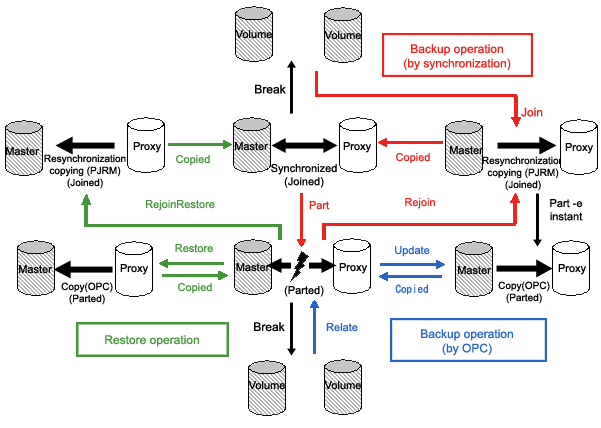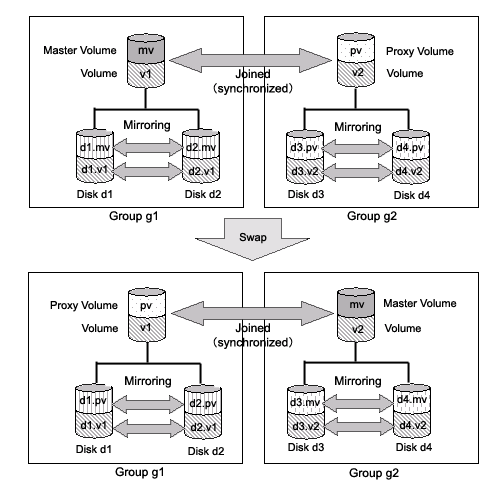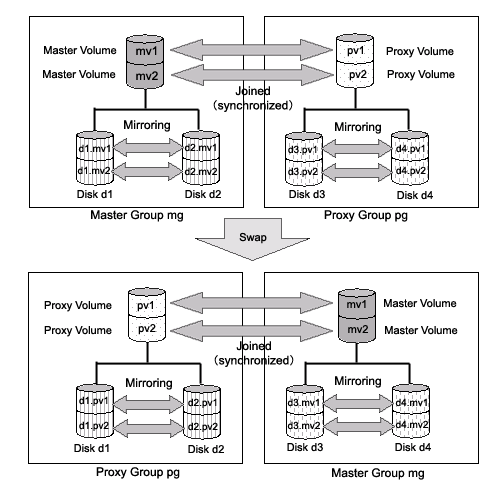An SDX object which is related to another SDX object (called master object) and plays the role of substitution of the master object is called a proxy object.
There are two kinds of proxy objects. The one is a proxy volume and the other is a proxy group.
A proxy volume can be joined and synchronized to a master volume, and they can be temporarily parted to become accessible as separate volumes. By joining and synchronizing the proxy volume to the master volume and then parting them, snapshot (copy at the moment) data of the master volume is instantly taken into the proxy volume.
A proxy group which is related to a master group has the same volume configuration as the master group. Each volume in the proxy group is a proxy volume of the corresponding master volume. By joining and synchronizing the proxy group to the master group and then parting them, snapshots of all the volumes in the master group are taken into the proxy group at a time.
Operation
The following operations are available for proxy objects.
A pair of specified master and proxy volumes or master and proxy groups will be related and synchronized with the sdxproxy Join command.
For details on GDS Management View, see "5.2.4.1 Join."
Master-proxy synchronization will be canceled and the proxy will be accessible as another device other than the master using the sdxproxy Part command. The master-proxy relationship will be maintained. The parted proxy will be a snapshot (a replication) of the master at that moment.
For details on GDS Management View, see "5.3.2.2 Backup (by Synchronization)."
The parted master and proxy will be resynchronized with the sdxproxy Rejoin command.
For details on GDS Management View, see "5.3.2.2 Backup (by Synchronization)."
The parted proxy is rejoined with the master, and master volume data will be restored using the proxy with the sdxproxy RejoinRestore command.
For details on GDS Management View, see "5.3.3 Restore."
The slices composing the master and those composing the proxy will be exchanged with the sdxproxy Swap command.
For details on GDS Management View, see "5.3.5 Disk Migration."
A pair of a master volume and a proxy volume or a master group and a proxy group can be related and parted, with the sdxproxy Relate command.
For details on GDS Management View, see "5.2.4.2 Relate."
Data can be copied (overwritten) from a master to a parted proxy with the sdxproxy Update command. The updated proxy becomes a snapshot (a replica) of the master at the moment.
For details on GDS Management View, see "5.3.2.3 Backup (by OPC)."
Data from a parted proxy can be restored back to the master with the sdxproxy Restore command. The proxy data at the moment is copied (overwritten) to the master.
For details on GDS Management View, see "5.3.3 Restore."
The session of a copy function of a disk unit residing between the master and the parted proxy can be canceled with the sdxproxy Cancel command.
The operation from GDS Management View is unsupported.
An environment can be set up with the sdxproxy Root command so that the system can be booted with the parted master or proxy.
The operation from GDS Management View is unsupported.
The specified relationship between a pair of volumes or groups as the master and proxy will be cancelled and they will return to individual objects with the sdxproxy Break command.
For details on GDS Management View, see "5.5.5 Breaking a Proxy."
Status
The relationship between master volumes and proxy volumes will be one of the following statuses. These statuses can be viewed in the PROXY field for volumes displayed with the sdxinfo command.
Master and proxy are joined. In this status, the proxy cannot be accessed.
Proxy is parted from the master and can be accessed independently from the master (unless the volume is stopped explicitly).
Reference
There are the following points of concern for proxy objects.
A.2.20 The Difference between a Mirror Slice and a Proxy Volume
A.2.21 Just Resynchronization Mechanism (JRM)
A.2.22 Object Operation When Using Proxy
A.2.23 Using the Advanced Copy Function in a Proxy Configuration
A.2.24 Instant Snapshot by OPC
A.2.27 Using Dell EMC TimeFinder or Dell EMC SRDF in a Proxy Configuration
Figure 2.8 Operating Proxy Objects

Figure 2.9 Swapping Master Volume and Proxy Volume

Figure 2.10 Swapping Master Group and Proxy Group
